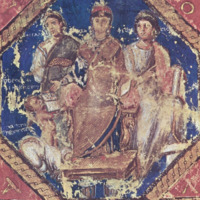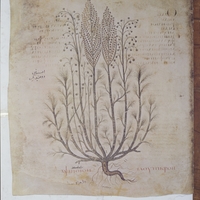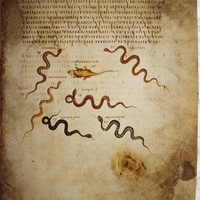Anicia Juliana's scientific codex
Type:
Churches,
Illuminated manuscripts
Date:
512
Dimensions:
36.5 × 30.6 cm
Description:
In addition to building Hagios Polyeuktos and other churches, the early Byzantine princess Anicia Juliana (462–527) supported the preservation of ancient knowledge. She was the recipient and probably the patron of a manuscript now preserved in Vienna (almost 500 extant folios). Known as the Anicia Juliana Codex and dated 512/13, it contains the Materia medica, a scientific work by the first-century CE botanist and physician Dioskorides (ca. 40–90) whose five-volume encyclopedia was widely read for centuries. The codex also has scientific works by other authors on herbs, poisons, birds, and fish, and many of the flora and fauna receive detailed illustrations (Arabic inscriptions were added after the Ottoman conquest of Constantinople in 1453, which proves that the book continued to be used).
Grouped at the beginning are "portraits" of the ancient authors whose works appear in the codex, including three of Dioskorides. On fol. 4v, he sits at the left as a mandrake root is held up for his observation by a female personification labeled "Discovery." Mandrakes were widely used in ancient and medieval magic. The human-shaped root was said to screech and cause death when dug up (they feature in Harry Potter; see https://www.hp-lexicon.org/thing/mandrake/), but if a dog were tied to the root, it would die in place of a human. This explains the presence of the poor canine at the center of this illumination. Dioskorides discovered the root's genuine medical potential: it contains a powerful alkaloid that has narcotic and other uses.
This codex also contains what may be the earliest manuscript portrait of a living donor, Anicia Juliana herself (fol. 6v). Wearing a gold and pearl diadem and classical garments highlighted in gold, the enthroned figure is flanked by personifications of Magnanimity and Prudence; at her feet is a kneeling figure identified as "Gratitude of the Arts." A putto labeled "Desire of the Woman Devoted to Building" presents her with a copy of this manuscript as she drops coins onto it. The image is framed by an illusionistic rope border. The eight red triangles contain golden letters that spell IOULIANA, beginning with the I above her head. On the thin black border inside the rope, a poem in praise of Juliana is written in tiny script; each line begins with one of the letters of her name. The poem calls her "queen," praises her noble family, and says that the citizens of Honoratae thank her for building a "towering" church in that suburb Constantinople (a different source says that church was completed in 512). In the blue compartments, putti rendered in grisaille are engaged in masonry and carpentry work for that church. The page thus underscores Anicia Juliana's wisdom and generosity as a patron of churches and of learning in early sixth-century Constantinople. These were activities that befit an empress, and Anicia Juliana must have hoped that she she or her son would sit on the Byzantine throne—hopes that were dashed when Justinian I rose to power in 527 as a result of military success rather than lineage or education.
Grouped at the beginning are "portraits" of the ancient authors whose works appear in the codex, including three of Dioskorides. On fol. 4v, he sits at the left as a mandrake root is held up for his observation by a female personification labeled "Discovery." Mandrakes were widely used in ancient and medieval magic. The human-shaped root was said to screech and cause death when dug up (they feature in Harry Potter; see https://www.hp-lexicon.org/thing/mandrake/), but if a dog were tied to the root, it would die in place of a human. This explains the presence of the poor canine at the center of this illumination. Dioskorides discovered the root's genuine medical potential: it contains a powerful alkaloid that has narcotic and other uses.
This codex also contains what may be the earliest manuscript portrait of a living donor, Anicia Juliana herself (fol. 6v). Wearing a gold and pearl diadem and classical garments highlighted in gold, the enthroned figure is flanked by personifications of Magnanimity and Prudence; at her feet is a kneeling figure identified as "Gratitude of the Arts." A putto labeled "Desire of the Woman Devoted to Building" presents her with a copy of this manuscript as she drops coins onto it. The image is framed by an illusionistic rope border. The eight red triangles contain golden letters that spell IOULIANA, beginning with the I above her head. On the thin black border inside the rope, a poem in praise of Juliana is written in tiny script; each line begins with one of the letters of her name. The poem calls her "queen," praises her noble family, and says that the citizens of Honoratae thank her for building a "towering" church in that suburb Constantinople (a different source says that church was completed in 512). In the blue compartments, putti rendered in grisaille are engaged in masonry and carpentry work for that church. The page thus underscores Anicia Juliana's wisdom and generosity as a patron of churches and of learning in early sixth-century Constantinople. These were activities that befit an empress, and Anicia Juliana must have hoped that she she or her son would sit on the Byzantine throne—hopes that were dashed when Justinian I rose to power in 527 as a result of military success rather than lineage or education.
Relevant Textbook Chapter(s):
3
Repository and Online Resources:
• Zoom in on the page with Dioskorides and the mandrake here.
• Zoom in on the Anicia Juliana page here.
Image Credits:
Österreichische Nationalbibliothek





